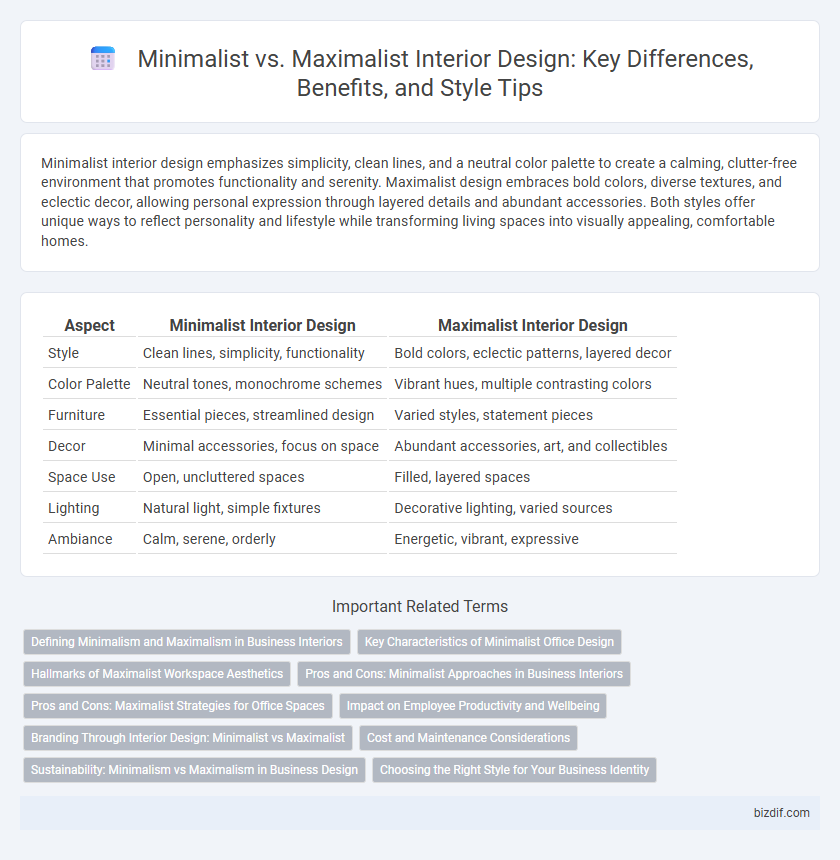Minimalist interior design emphasizes simplicity, clean lines, and a neutral color palette to create a calming, clutter-free environment that promotes functionality and serenity. Maximalist design embraces bold colors, diverse textures, and eclectic decor, allowing personal expression through layered details and abundant accessories. Both styles offer unique ways to reflect personality and lifestyle while transforming living spaces into visually appealing, comfortable homes.
Table of Comparison
| Aspect | Minimalist Interior Design | Maximalist Interior Design |
|---|---|---|
| Style | Clean lines, simplicity, functionality | Bold colors, eclectic patterns, layered decor |
| Color Palette | Neutral tones, monochrome schemes | Vibrant hues, multiple contrasting colors |
| Furniture | Essential pieces, streamlined design | Varied styles, statement pieces |
| Decor | Minimal accessories, focus on space | Abundant accessories, art, and collectibles |
| Space Use | Open, uncluttered spaces | Filled, layered spaces |
| Lighting | Natural light, simple fixtures | Decorative lighting, varied sources |
| Ambiance | Calm, serene, orderly | Energetic, vibrant, expressive |
Defining Minimalism and Maximalism in Business Interiors
Minimalism in business interiors emphasizes clean lines, neutral color palettes, and functional furniture to create an uncluttered and calming work environment that enhances productivity. Maximalism embraces bold colors, diverse textures, and a mix of patterns and artwork to foster creativity and express a company's unique identity. Choosing between minimalist and maximalist designs depends on the brand ethos, workspace needs, and the desired impact on employees and clients.
Key Characteristics of Minimalist Office Design
Minimalist office design emphasizes simplicity, clean lines, and functional furniture to create an uncluttered workspace that enhances productivity. Key characteristics include a neutral color palette, ample natural light, and minimal decorative elements, focusing on essential items only. This design approach prioritizes open space and organization, reducing distractions and promoting mental clarity.
Hallmarks of Maximalist Workspace Aesthetics
Maximalist workspace aesthetics are defined by bold color palettes, eclectic decor, and a mix of textures that create an energizing and personalized environment. Walls are often adorned with vibrant artwork, shelves brimming with books and collectibles, and statement furniture pieces that combine functionality with artistic flair. This style emphasizes abundance and self-expression, transforming the workspace into a dynamic area that stimulates creativity and reflects the occupant's unique identity.
Pros and Cons: Minimalist Approaches in Business Interiors
Minimalist business interiors offer streamlined aesthetics that enhance focus and create a spacious, clutter-free environment, promoting productivity and calm. The minimalist approach reduces maintenance costs and facilitates easy cleaning, but may risk feeling cold or impersonal if overused, potentially impacting employee comfort. Balancing functionality with simplicity, minimalist design maximizes natural light and uses neutral palettes, though it might lack the warmth or personality that maximalist elements provide.
Pros and Cons: Maximalist Strategies for Office Spaces
Maximalist strategies for office spaces create vibrant, dynamic environments through layered textures, bold colors, and eclectic decor that stimulate creativity and energy. However, this approach can lead to sensory overload and reduced focus if not carefully balanced, potentially impacting productivity. Maximalist designs require thoughtful curation to maintain functionality while expressing individuality and brand identity.
Impact on Employee Productivity and Wellbeing
Minimalist office designs promote employee productivity by reducing distractions and creating a calm, organized environment, which enhances focus and mental clarity. Maximalist spaces, with their vibrant colors and eclectic decor, stimulate creativity and inspire innovation but may increase cognitive overload for some employees. Balancing these styles based on individual work tasks and employee preferences can optimize both wellbeing and performance in the workplace.
Branding Through Interior Design: Minimalist vs Maximalist
Minimalist interior design leverages simplicity and clean lines to create a sleek, focused brand atmosphere that emphasizes clarity and sophistication, often using neutral color palettes and functional furnishings. Maximalist design employs rich textures, bold patterns, and vibrant colors to craft a dynamic and expressive brand identity that captures attention and conveys personality through eclectic decor. Both styles strategically influence customer perception and experience, making them powerful tools for branding through interior design.
Cost and Maintenance Considerations
Minimalist interior design typically incurs lower initial costs and reduced maintenance expenses due to its emphasis on simplicity, fewer decorative elements, and streamlined furniture. Maximalist interiors often require higher investment in diverse furnishings, accessories, and intricate detailing, leading to increased upkeep and cleaning efforts. Budget-conscious homeowners may find minimalism economically advantageous, while maximalism demands ongoing commitment to organization and preservation.
Sustainability: Minimalism vs Maximalism in Business Design
Minimalist interior design in business prioritizes sustainability by reducing material consumption and promoting energy-efficient spaces through clean lines and functional furniture. Maximalist design often incorporates diverse, upcycled elements and layered textures that support sustainability by reusing existing materials and reducing waste. Both approaches contribute to eco-friendly business environments by emphasizing responsible sourcing and longevity in interior elements.
Choosing the Right Style for Your Business Identity
Selecting between minimalist and maximalist interior design depends on aligning the aesthetic with your business identity and target audience. Minimalist design emphasizes clean lines, neutral palettes, and functional spaces, ideal for brands seeking a sleek, modern, and uncluttered environment. Maximalist design incorporates bold colors, diverse textures, and eclectic decor, suited for businesses aiming to convey creativity, richness, and a dynamic atmosphere.
Minimalist vs Maximalist Infographic

 bizdif.com
bizdif.com